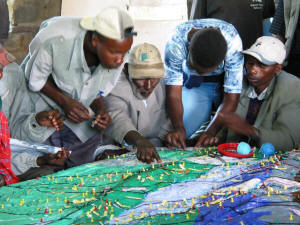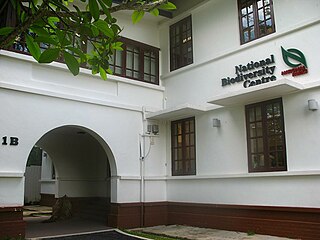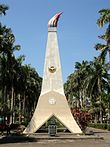
The Convention on Biological Diversity (CBD), known informally as the Biodiversity Convention, is a multilateral treaty. The Convention has three main goals: the conservation of biological diversity ; the sustainable use of its components; and the fair and equitable sharing of benefits arising from genetic resources. Its objective is to develop national strategies for the conservation and sustainable use of biological diversity, and it is often seen as the key document regarding sustainable development.

Environmental laws are laws that protect the environment. Environmental law is the collection of laws, regulations, agreements and common law that governs how humans interact with their environment. This includes environmental regulations; laws governing management of natural resources, such as forests, minerals, or fisheries; and related topics such as environmental impact assessments. Environmental law is seen as the body of laws concerned with the protection of living things from the harm that human activity may immediately or eventually cause to them or their species, either directly or to the media and the habits on which they depend.

Protected areas or conservation areas are locations which receive protection because of their recognized natural, ecological or cultural values. Protected areas are those areas in which human presence or the exploitation of natural resources is limited.
This is an index of conservation topics. It is an alphabetical index of articles relating to conservation biology and conservation of the natural environment.

The Association of Southeast Asian Nations, commonly as ASEAN, is a political and economic union of 10 states in Southeast Asia. Together, its member states represent a population of over 600 million over a land area of 4.5 million km2 (1.7 million sq mi). The bloc generated a purchasing power parity (PPP) gross domestic product (GDP) of around US$10.2 trillion in 2022, constituting approximately 6.5% of global GDP (PPP). ASEAN member states include some of the fastest growing economies in the world.

The ASEAN Free Trade Area (AFTA) is a trade bloc agreement by the Association of Southeast Asian Nations supporting local trade and manufacturing in all ASEAN countries, and facilitating economic integration with regional and international allies. It stands as one of the largest and most important free trade areas (FTA) in the world, and together with its network of dialogue partners, drove some of the world's largest multilateral forums and blocs, including Asia-Pacific Economic Cooperation, East Asia Summit and Regional Comprehensive Economic Partnership.

Environmental protection is the practice of protecting the natural environment by individuals, groups and governments. Its objectives are to conserve natural resources and the existing natural environment and, where it is possible, to repair damage and reverse trends.
The UN Environment Programme World Conservation Monitoring Centre (UNEP-WCMC) is the specialist biodiversity centre of UN Environment Programme, based in Cambridge in the United Kingdom. UNEP-WCMC has been part of UN Environment Programme since 2000 and has responsibility for biodiversity assessment and support to policy development and implementation. The "World Conservation Monitoring Centre" was previously an independent organisation jointly managed by IUCN, UN Environment Programme and WWF established in 1988. Prior to that, the centre was a part of the IUCN Secretariat.

Participatory 3D modelling (P3DM) is a community-based mapping method which integrates local spatial knowledge with data on elevation of the land and depth of the sea to produce stand-alone, scaled and geo-referenced relief models. Essentially based on local spatial knowledge, land use and cover, and other features are depicted by informants on the model by the use of pushpins (points), yarns (lines) and paints (polygons). On completion, a scaled and geo-referenced grid is applied to facilitate data extraction or importation. Data depicted on the model are extracted, digitised and plotted. On completion of the exercise the model remains with the community.
Partnerships in Environmental Management for the Seas of East Asia (PEMSEA) is a regional partnership programme implemented by the United Nations Development Programme (UNDP) and executed by the United Nations Office for Project Services (UNOPS). The project, started in 1994, was originally known as Prevention and Management of Marine Pollution in the East Asian Seas (SDS-SEA).

The National Biodiversity Centre is a branch of the National Parks Board and serves as Singapore's one-stop centre for biodiversity-related information and activities. It manages all available information and data on biodiversity in Singapore. Diverse biodiversity-related information and data are currently generated, stored and updated by different organisations and individuals. The National Biodiversity Centre will maximize the usefulness of such information and data by linking them in a single meta-database. Having complete and up-to-date information is crucial for many decision-making processes involving biodiversity. This hub of biodiversity information and data at the National Biodiversity Centre will also allow knowledge gaps to be better identified and addressed.

Ramón Jesús Palmiano Paje is a Filipino civil servant. He was the 19th secretary of the Department of Environment and Natural Resources (DENR) under the administration of President Benigno Aquino III. Prior to his appointment, he was DENR Undersecretary for Field Operations and Executive Director of the Minerals Development Council under the Office of the President in concurrent capacity.

The European Centre for Nature Conservation (ECNC) was a Dutch non-profit foundation which was active in the field of European nature and biodiversity policy between 1993 and 2017. It was set up as a network of university departments, expert centres and government agencies and operated as a European biodiversity expertise centre. The organization promoted sustainable management of natural resources and biodiversity, and aimed to stimulate interaction between science, society and policy.
The ASEAN Wildlife Enforcement Network (ASEAN-WEN) was officially launched on 1 December 2005, as a regional inter-agency and inter-governmental initiative to counter the illegal cross-border trade in endangered flora and fauna. It helps countries share information on and tackle cross-border wildlife crime and facilitates the exchange of regional best practices in combating those crimes. As the world's largest wildlife law enforcement network, it comprises the law enforcement agencies of the 10 ASEAN countries forming a regional intergovernmental law-enforcement network.
ASEAN Heritage Parks (AHP) are selected protected areas in the ASEAN region that are known for their unique biodiversity and ecosystems, wilderness and outstanding values in scenic, cultural, educational, research, recreational and tourism. Its vision is "An ASEAN region whose biological is conserved, sustainably managed and used, and equitably shared for the well-being of its peoples." The ASEAN Centre for Biodiversity (ACB) in the Philippines serves as the secretariat of the ASEAN Heritage Parks Programme.

The Mounts Iglit–Baco Natural Park (MIBNP) is a legislated protected area of the Philippines and an ASEAN Heritage Park located in the island of Mindoro in central Philippines. First established in 1970 by virtue of Republic Act No. 6148 as "National Park" that covers an area of 75,445 hectares surrounding Mount Iglit and Mount Baco in the central interior of Mindoro. The park is the home of the largest remaining population of the critically endangered Tamaraw. In 2003, the Association of Southeast Asian Nations listed it as one of its four heritage parks in the Philippines. The park has also been nominated in the Tentative List of UNESCO World Heritage Sites in 2006. In 2018, the park was designated as a “Natural Park” under the Republic Act No. 11038 or the Expanded National Integrated Protected Areas Systems (ENIPAS) Act of 2018 and increased the area to 106,655.62 hectares.

This is a list of topics in biodiversity.
ASEAN Center for Energy (ACE) is a regional intergovernmental organisation within the ASEAN structure that pursues the interests of the 10 ASEAN Member States in the energy sector. ACE was established on 1 January 1999. The organisation plays a central role in the ASEAN energy sector. It works closely with energy specialists/services in the 10 AMS called the Sub-sector Networks (SSN) and the Specialised Energy Bodies (SEB) and with the ASEAN Secretariat. Together, they develop and implement the ASEAN Plan of Action for Energy Cooperation (APAEC), a blueprint for better energy collaboration among the ASEAN member states. The executive director of ACE is Dr Nuki Agya Utama.
Leticia "Letty" E. Afuang is a Filipina biologist and wildlife conservationist currently working as a professor under the Animal Biology Division of the Institute of Biological Sciences (IBS) at the University of the Philippines Los Baños (UPLB), located in the Philippine province of Laguna. She is also one of the main curators for the Zoological and Wildlife Collection at the UPLB Museum of Natural History. While known as the "Snake Lady," her research as a herpetologist also focuses on other reptiles, amphibians and a wide array of herpetofauna across the Philippine islands. As an advocate for environmental sustainability, she has founded multiple organizations such as the Mindoro Biodiversity Conservation Foundation and the Biodiversity Conservation Society of the Philippines.












